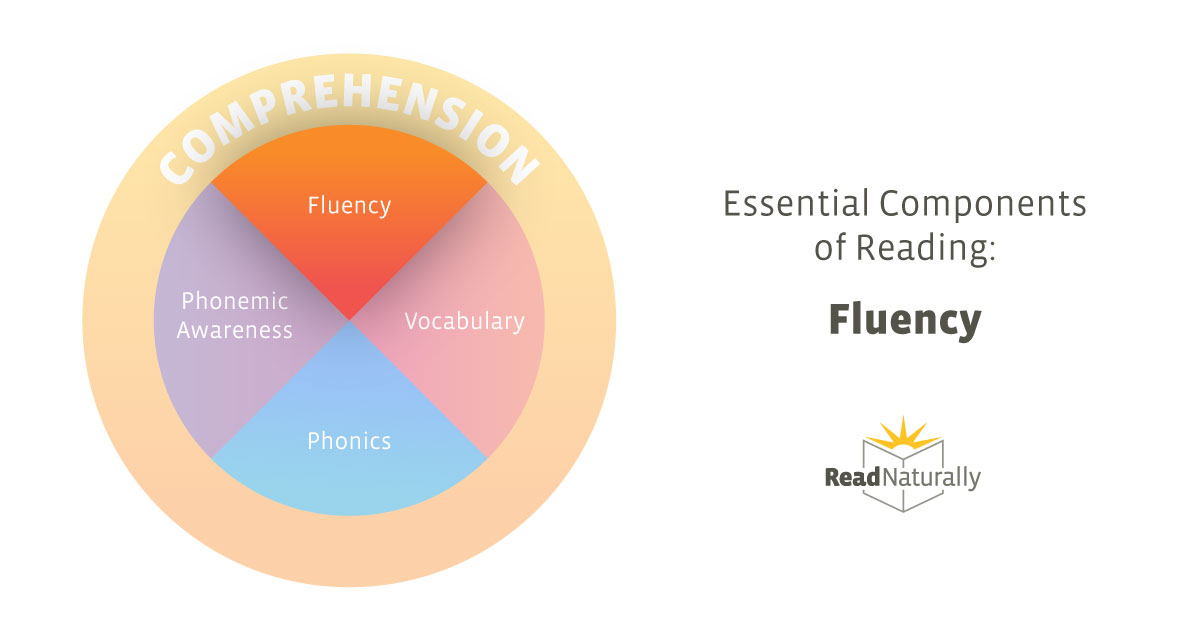
What Is Fluency?
Fluency is the ability to read "like you speak." Hudson, Lane, and Pullen define fluency this way: "Reading fluency is made up of at least three key elements: accurate reading of connected text at a conversational rate with appropriate prosody or expression." Non-fluent readers suffer in at least one of these aspects of reading: they make many mistakes, they read slowly, or they don't read with appropriate expression and phrasing.
 Developing reading fluency with Read Naturally Strategy programs
Developing reading fluency with Read Naturally Strategy programs
Key Concepts
Why Is Fluency Important?
For many years, educators have recognized that fluency is an important aspect of reading. Reading researchers agree. Over 30 years of research indicates that fluency is one of the critical building blocks of reading, because fluency development is directly related to comprehension.
Here are the results of one study by Fuchs, Fuchs, Hosp, and Jenkins that shows how oral reading fluency correlates highly with reading comprehension.
| Measure | Validity Coefficient |
| Oral Recall/Retelling | .70 |
| Cloze (fill in the blank) | .72 |
| Question Answering | .82 |
| Oral Reading Fluency | .91 |
To interpret this type of correlation data, consider that a perfect match would be 1.0. As you can see, oral recall/retelling, fill in the blank, and question answering are all above 0.6, which indicates there is a strong correlation. But oral reading fluency is by far the strongest, with a .91 correlation.
Many researchers, including Breznitz, Armstrong, Knupp, Lesgold, and Pinnell, have found that fluency is highly correlated with reading comprehension—that is, when a student reads fluently, that student is likely to comprehend what he or she is reading.
Why are reading fluency and reading comprehension so highly correlated? Dr. S. Jay Samuels, a professor and researcher well known for his work in fluency, put forth a theory called the automaticity theory. According to Dr. Samuels, people have a limited amount of mental energy. If you want to multitask or to become proficient at a complex task such as reading, you first need to master the component tasks so you can do them automatically. For example, a reader who must focus his or her attention on decoding words may not have enough mental energy left over to think about the meaning of the text. However, a fluent reader who can automatically decode the words can instead give full attention to comprehending the text. To become proficient readers, our students need to become automatic with text so they can pay attention to the meaning.
See also:
Challenges Faced by Non-Fluent Readers
Students become fluent by reading. Some students learn to read fluently without explicit instruction. For others, however, fluency doesn't develop in the course of normal classroom instruction.
Research analyzed by the National Reading Panel suggests that just encouraging students to read independently isn't the most effective way to improve reading achievement. Too often, simply encouraging at-risk students to read doesn't result in increased reading on their part. During sustained silent reading, at-risk readers may get a book with mostly pictures and look at the pictures, or they choose a difficult book so they will look like everyone else and then pretend to read.
Even if at-risk students do read, they read more slowly than the other students. In a 10-minute reading period, a proficient reader who reads 200 words a minute silently could read 2,000 words. In the same 10 minutes, an at-risk student who reads 50 words a minute would only read 500 words. This is equal reading time but certainly not an equal number of words read.
These students need to read more, but just asking them to read on their own often doesn't work. The National Reading Panel has concluded that a more effective course of action is for us to explicitly teach developing readers how to read fluently, step by step.
Research-Proven Fluency Strategies
How do we explicitly teach students to read fluently? The National Reading Panel found data supporting three strategies that improve fluency, comprehension, and reading achievement—teacher modeling, repeated reading, and progress monitoring.
Teacher Modeling
The first strategy is teacher modeling. Research demonstrates that various forms of modeling can improve reading fluency. Examples of teacher modeling include:
- Teacher-assisted reading
- Peer-assisted reading
- Audio-assisted reading
Teacher modeling involves more than just listening to someone else read. Students must be actively involved 100 percent of the time and in a multisensory way.
Teacher modeling teaches word recognition in a meaningful context, demonstrates correct phrasing, and gives students practice tracking across the page. A child can benefit from teacher modeling once he or she knows at least 50 sight words and has a good sense of beginning sounds.
The reading rate of the model reader is important. Christopher Skinner, a reading researcher, found that students who read lists of words with him slowly were more fluent with the words than students who read with him at a faster rate. The slower rate enables students to learn new words and clarify difficult words. As students learn more words, they naturally become more fluent.
Another form of modeling is the neurological impress method. In the neurological impress method, a proficient and a struggling reader read together from a passage, with the more able reader reading near the rate of the struggling reader. Heckelman (1969) showed that after 29 15-minute sessions, 24 seventh- through ninth-grade boys, who were an average of 3 years behind in reading, gained an average of 1.9 years in reading based on the Oral Gilmore and the California Achievement Test.
Repeated Reading
Another technique that research has shown significantly builds reading fluency is repeated reading. In fact, the National Reading Panel says this is the most powerful way to improve reading fluency. This involves simply reading the same material over and over again until accurate and expressive.
In the 1970s, LaBerge and Samuels studied what happens when students read passages over and over again. They found that when students reread passages, they got faster at reading the passages, understood them better, and were able to read subsequent passages better as a result of the repeated reading.
Repeated reading is a form of mastery learning. The students read the same words so many times that they begin to know them and are able to identify them in other text. Besides helping students bring words to mastery, repeated reading changes the way students view themselves in relation to the act of reading.
Progress Monitoring
People who play video games are presented with a specific goal and with immediate, relevant feedback about their progress toward that goal. This combination of having a goal and getting feedback on progress can be very motivating.
Progress monitoring takes advantage of this combination to motivate students to read. You give students a specific, individual reading goal, and you tell them exactly how you're going to know they've met it. Then, you give them the means to measure how they're doing. Finally, you make it simple enough that they'll know they've met their goal even before you do. This progress monitoring is what motivates students to practice reading the same story over and over until achieving mastery.
 Developing Reading Fluency With Read Naturally Strategy Programs
Developing Reading Fluency With Read Naturally Strategy Programs
The research-based Read Naturally Strategy combines these three strategies into highly effective programs that accelerate reading achievement. Students become confident readers by developing fluency, phonics skills, comprehension, and vocabulary while reading leveled text. The time-tested intervention programs engage students with interesting nonfiction stories and yield powerful results.
 Learn more about the Read Naturally Strategy
Learn more about the Read Naturally Strategy
 Research basis for the Read Naturally Strategy
Research basis for the Read Naturally Strategy
The Read Naturally Strategy is available in a variety of formats:
 Choosing the right Read Naturally Strategy program
Choosing the right Read Naturally Strategy program
 | One Minute Reader®
Structured, supplemental reading program for developing literacy skills independently. Available in these formats:
 One Minute Reader Live (component of web-based Read Live for supplemental reading at school) One Minute Reader Live (component of web-based Read Live for supplemental reading at school)
 One Minute Reader books/audio CDs (for a school-to-home checkout program) One Minute Reader books/audio CDs (for a school-to-home checkout program) |
Bibliography
Armstrong, S. W. (1983). The effects of material difficulty upon learning disabled children's oral reading and reading comprehension. Learning Disability Quarterly, 6, pp. 339–348.
Breznitz, Z. (1987). Increasing first graders' reading accuracy and comprehension by accelerating their reading rates. Journal of Educational Psychology, 79(3), pp. 236–242.
Fuchs, L. S., Fuchs, D., Hosp, M. K., & Jenkins, J. R. (2001). Oral reading fluency as an indicator of reading competence: A theoretical, empirical, and historical analysis. Scientific Studies of Reading, 5(3), pp. 239–256.
Heckelman, R. G. (1969). A neurological-impress method of remedial-reading instruction. Academic Therapy Quarterly, 5(4), pp. 277–282.
Hudson, R. F., H. B. Lane, and P. C. Pullen. (2005). Reading fluency assessment and instruction: What, why, and how. Reading Teacher 58(8), pp. 702-714.
Knupp, R. (1988). Improving oral reading skills of educationally handicapped elementary school-aged students through repeated readings. Practicum paper, Nova University (ERIC Document Reproduction Service No. ED 297275).
LaBerge, D., & Samuels, S. J. (1974). Toward a theory of automatic information processing in reading. Cognitive Psychology, 6, pp. 292–323.
Lesgold, A., Resnick, L. B., & Hammond, K. (1985). Learning to read: A longitudinal study of word skill development in two curricula. In G. Waller & E. MacKinon (eds.), Reading research: Advances in theory and practice. New York, NY: Academic Press.
National Reading Panel. (2000). Teaching children to read: An evidence-based assessment of the scientific research literature on reading and its implications for reading instruction. Washington, DC: National Institute of Child Health and Human Development.
Pinnell, G. S., Pikulski, J. J., Wixson, K. K., Campbell, J. R., Gough, P. B., & Beatty, A. S. (1995). Listening to children read aloud: Data from NAEP's integrated reading performance record (IRPR) at grade 4 (NCES Publication 95-726). Washington, DC: U.S. Department of Education, National Center for Educational Statistics.
Samuels, S. J. (2002). Reading fluency: Its development and assessment. In A. E. Farstrup & S. J. Samuels (eds.), What research has to say about reading instruction, 3rd ed., pp. 166–183. Newark, DE: International Reading Association.
Samuels, S. J. (1997). The method of repeated readings. The Reading Teacher, 50(5), pp. 376–381.
Samuels, S. J. (2006). Towards a model of reading fluency. In S. J. Samuels and A. E. Farstrup (eds.), What research has to say about fluency instruction. Newark, DE: International Reading Association.
Samuels, S. J. (1997). The method of repeated readings. The Reading Teacher, 50(5), pp. 376–381.
Skinner, C. H., Logan, P., Robinson, S. L., & Robinson, D. H. (1997). Demonstration as a reading intervention for exceptional learners. School Psychology Review, 26(3), pp. 437–447.










